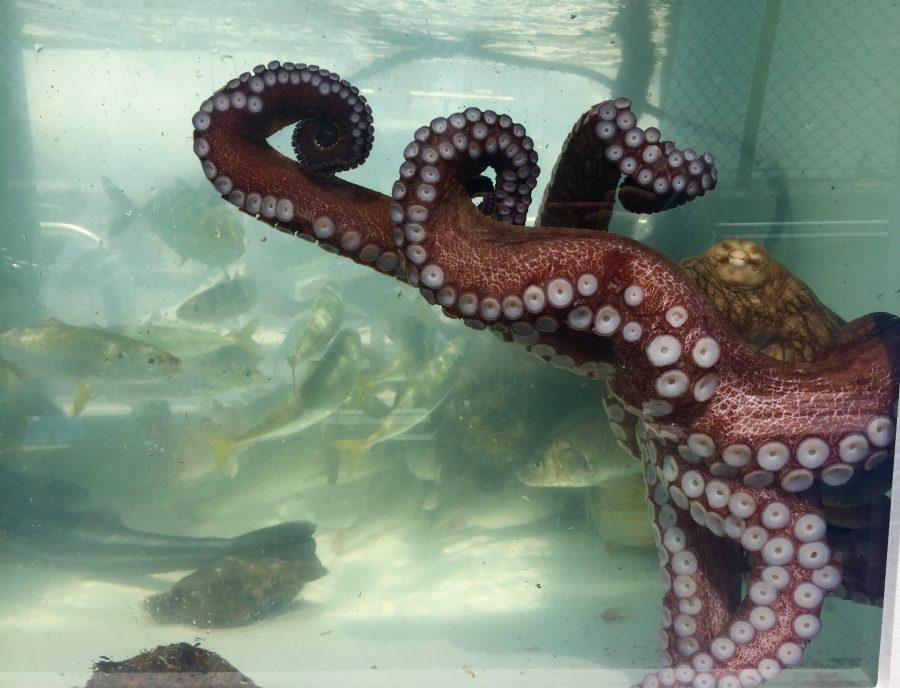Common Octopus
Florida's Eight-Armed Sea Creature - Common Octopus
Why yes, yes it is! Recently in our touch tank on the tours, we have had an octopus called the Octopus Vulgaris, or also known as the common octopus. I personally interacted with the octopus after a tour one day. She was a lot friendlier than I imagined. Her skin was really smooth and slimy. The octopus’s tentacles tickled me while wrapping on my arm and her suckers felt like little suction cups. In our touch tank, the tour guides have seen her eat blue crabs, stone crabs, urchins, shrimp, pogeys, and croakers. That means that the common octopuses are quite the carnivores.

HABITAT
The common octopus exists worldwide in large quantities in the Eastern Atlantic Ocean (which is where we are located), Mediterranean Sea, and in Japanese waters. They live in the upper part of the continental shelf, coastal waters, and like temperate, tropical, and subtropical waters. The common octopus is in shallow waters and they go as deep as 100-150 meters.

ABOUT
Including their arms, the common octopus reaches 1-3 feet in length. They can weigh anywhere between 6-22 lbs. The octopus has a total of eight distinctive arms which are connected to their globe-shaped head also known as a mantle. They have two rows of suckers on each of their tentacles and can use them to sense taste. When an octopus loses a tentacle they have the ability to regenerate another one. Recent studies have shown that the octopus’s tentacles are not actually all arms and that two of their tentacles act more as legs. This allows them to push off when swimming and walk across the sea floor. The common octopus is considered a mollusk, which is an invertebrate with a shell and soft bodied. To protect their brain, they do have a skull but no skeletal structure. To pry open and drill into prey with shells, they have a toothed tongue called radula and a sharp beak. Sometimes when the common octopus breaks into the shell they will inject a poison into their prey that’s paralyzing.
HOW MANY TICKLES DOES IT TAKE TO GET THE OCTOPUS TO LAUGH? TENTACLES!


REPRODUCTION
When mating season comes around the octopuses move closer to shore during early spring. In shallow waters, the females release 100,000-500,000 eggs two months after mating. Eggs are laid in man-made objects like bottles, cans, shoes, tires, or empty mollusk shells. She spends a lot of her time cleaning the eggs and keeping predators away. The female octopus will also squirt water to provide oxygen to the eggs as well. Females will find a sheltered place on a rocky shore in coral, rocks, or a crevice. Then they scatter shells and rocks around to hide their homes. During the next few months, the female octopus will not feed while caring for the eggs and she will slowly waste away. Hatchlings are carried away by currents and will feed off of plankton for awhile.
BEHAVIOR
The common octopus is a pretty fast swimmer. They can reach up to the speeds of 25 MPH. If the octopus wants to make a quick escape they expel water through their mantles which jet them forward. Out of all invertebrates, they’re considered the most intelligent. The octopus can learn and make discriminations based on chemical cues, visual, and tactile. What’s super fascinating about them is that their soft bodies can fit through the smallest cracks or crevices! The common octopus spends most of their lives alone in a den. They’re solitary and territorial. While some will stay in the same home for a long time, others will change out their home every 1-2 weeks. The octopus is nocturnal and leave their den at night for hunting trips and return in the morning.
DEFENSE
The common octopus has pigment cells in their skin which gives them the ability to camouflage. They can also blend in with their surroundings by changing their body posture and the texture of their skin. The octopus can camouflage just about instantaneously that some of their predators such as dolphins, sharks, and eels will swim by without even noticing them. If the octopus feels they’ve been noticed by a predator, they will release a cloud of black ink. The ink will obscure the predators view while giving the octopus time to swim away. The ink also contains a chemical that weakens the predators smell making it harder for them to track the octopus.
DID YOU KNOW?
In the wild, the common octopus has a lifespan of 1-2 years.






